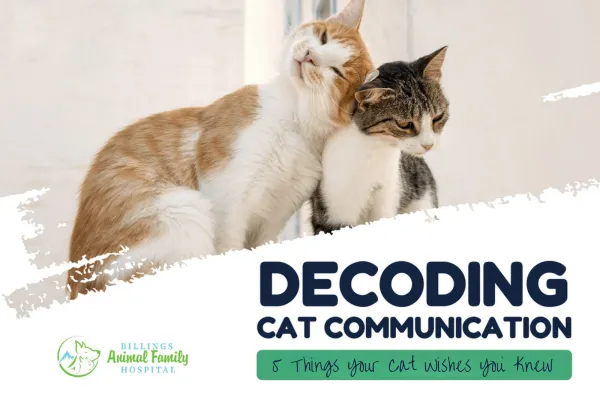
Understanding Cat Communication and What Your Feline Wants
Cat Communication: Five Things Your Cat Wishes You Knew Before Having Them
Cat communication isn’t always obvious. Unlike dogs, who wag their tails or offer a playful bow, cats rely on more subtle signals. It can take years for cat owners to truly understand their feline companions and build the trust and respect that make daily life smooth and pleasant.
What if there were a way for you to understand what your cat wanted you to know? Would you want to hear what she had to say? If there were five things your cat wishes you knew, what would they be?
Sometimes a strong message is exactly what is needed to communicate without guessing, but until then, let’s look at five things your cat wishes you knew.
What You'll Find In This Post
Cat Communication: Five Things Your Cat Wishes You Knew Before Having Them
Five things your cat wishes you knew before having them
The litter box is their special place to freshen up
Cats feel the same anxious feeling you feel
Purring doesn’t always mean contentment or happiness
Ways cat communicates with their owners
Want more insights into cat communication and feline behavior?

Five things your cat wishes you knew before having them
Cats use subtle body language, vocalization, and social interaction to express their needs. This list of “things I wish I knew before getting a cat” will help you better understand cat communication and needs and strengthen your bond with your feline companion.
The litter box is their special place to freshen up
Your cat's litter box is a very particular place needing particular care so that they feel comfortable enough to use it. It must always be clean, so try to “strain” the clumps from their litter box at least once a day, as well as empty, wash, and replace the litter once a week.
The litter-box needs to be clean, accessible, and private for them to use, and while cleaning it, avoid lemon scents or other toxic cleaners. In resetting their special place, remember not to move it more than a couple of inches to maintain continuity and comfort.
Scratching things is a must
Scratching is an ingrained feline behavior and can truly be a need rather than just a habit. Rooted in the hunt-stalk lifestyle, scratching helps prepare, clean, and sharpen a cat’s claws before the chase.
It’s best to provide a sturdy scratching post, or even create one DIY, for your domestic cat, since this instinct is an essential part of cat behavior. This step not only protects your furniture but also gives your cat a safe, satisfying outlet to stretch, mark territory, and stay content.
Cats need entertainment, too
Cats also require mental stimulation to stay happy and healthy. A ball of yarn might not be enough (and isn’t always safe). Instead, create a system of toys, puzzles, or obstacle courses to satisfy her playful side. Sometimes the best form of entertainment is companionship, and introducing another cat can provide built-in playtime and social interaction.
Still, remember that the best entertainment comes from you. Cats communicate their joy through meowing, body posture, and even a satisfied purr during play. Spending intentional time together not only keeps your cat active but also strengthens your bond.
Cats feel the same anxious feeling you feel
Cats are highly intuitive, and your cat may mirror your own emotions. If you’re anxious, your pet may pick up on that energy, showing it through changes in body language or vocalization. Comforting her can be just as important as comforting yourself, creating balance and emotional well-being for both of you.
Purring doesn’t always mean contentment or happiness
Many people assume a purr always signals pleasure, but cats also purr when in pain, feeling anxious, or unwell. Watch your feline’s overall body posture and behaviour to know whether the purr is tied to relaxation or stress. Cats communicate with more than just vocalization—observing their actions alongside the sound will give you clearer insight.

Ways cat communicates with their owners
Cats use body language, scent, and touch in ways that communicate with humans and with cats or other animals. Understanding these signals helps improve the welfare of cats and strengthens your bond with your pet.
Vocal communication
Cat vocalizations like meows, trills, and cat purring are often used to communicate with humans. While wild cats rarely meow, domesticated cats meow to communicate needs like food, attention, or comfort. A cat makes different sounds depending on whether the cat is relaxed, anxious, or wants playtime.
Olfactory communication
Scent is one of the strongest ways in which cats communicate. When a cat rubs against furniture, cats often leaves scent markers from specific areas of the body. This body language and scent marking is especially common in male cats and female cats as part of territory and recognition in the domestic cat.
Tactile communication
Touch is another important part of feline communication. Pet cats may nuzzle, groom, or lie close to the body of their owner as a sign of trust. Licking between a cat and kitten, or between two cats, is used by cats to bond and show affection.
Cat body language
Cats use body language to show exactly how they feel. A tail held high usually means a cat is ready and confident, while a tail tucked close to the body often signals a fearful cat. Cat slow blinks, narrowing the eyes, or when cats hold their posture low, are all communication signals showing whether the cat is relaxed or if the cat feels threatened.
Want more insights into cat communication and feline behavior?
Check out these articles from Billings Animal Family Hospital:

Final thoughts
Knowing your cat's needs and wants can make them more content, happy, and healthy, which is paramount for good cat ownership. Special needs from your cat can be hard to identify, so pay special attention to her behavior for an understanding beyond the things your cat wishes you knew.
Make sure you’re always prepared in case of an emergency. Don’t forget to download our free Emergency Vet Contact Card and keep it handy for peace of mind. And if you ever notice changes in your cat's behavior, don't wait. Reach out for expert guidance.



